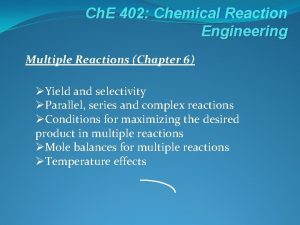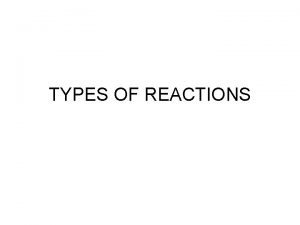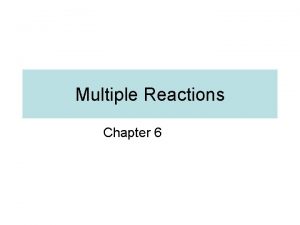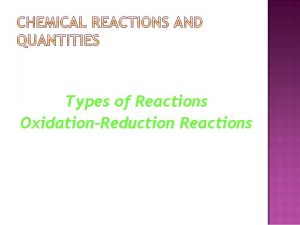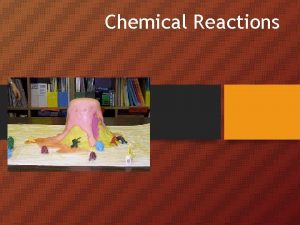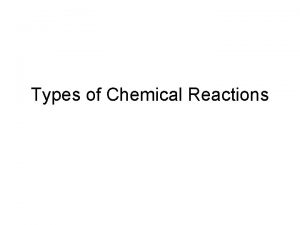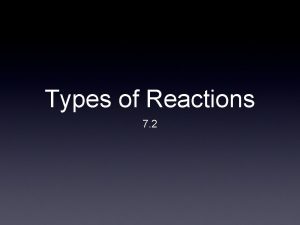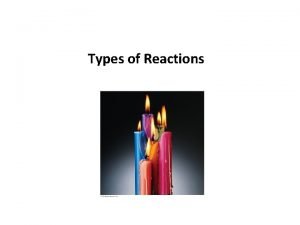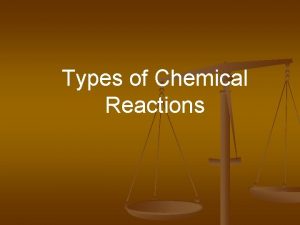Chapter 6 Multiple Reactions Overview Multiple reactions types


















- Slides: 18

Chapter 6 Multiple Reactions

Overview • Multiple reactions types • Define “Selectivity”. How it can be used in the design? • Solve engineering problems with multiple reactions

6. 1 Definitions • 6. 1. 1 Types of reactions There are four types of multiple reactions 1. Parallel reactions (competing reactions) where the reactant is consumed by two different reaction pathways to form different products e. g oxidation of ethylene to ethylene oxide 2. Series reactions (consecutive reactions) where the reactant forms an intermediate product, which reacts further to form another product e. g EO with NH 3 to form mono, di and triethanolamine

3. Complex reactions are reactions that involve a combination of both series and parallel reactions e. g formation of butadiene from ethanol 4. Independent reactions are reactions that occur at the same time independently e. g cracking of crude oil to form gasoline

• We want to minimize the formation of undesired products and maximize the formation of desired products to reduce the cost of separating undesired from desired products

Selectivity • Selectivity quantifies the formation of desired wrt undesired products • Instantaneous selectivity • Overall selectivity • For a batch reactor • For CSTR

Yield • Yield is defined as the ratio of the reaction rate of a given product to that of the key reactant • Instantaneous yield • Overall yield • For a batch reactor • For CSTR

6. 2 Parallel Reactions • We examine ways to maximize SD/U for parallel reactions

• Case 1: α 1>α 2 • Keep the conc of reactant A as high as possible – If gas phase no inerts and high pressure are used – If liquid phase use of diluents is minimized – Batch or PFR is used because conc drops progressively while in CSTR the conc is always at the lowest exit value • Case 2: α 1<α 2 • Keep the conc of reactant A as low as possible – Diluting the feed with inerts – Recyle reactor product – CSTR is used

• The sensitivity of the selectivity to the temperature can be determined from the reaction rates ratio • • • Case 3: ED>EU k. D and r. D↑ with temperature than Ku Keep temperature as high as possible Case 4: EU>ED Operate at low possible temperature

6. 3 Reactions in series For the sequence where B is the desired product • If the first reaction is slow and the second reaction is fast it will difficult to produce B • If the first reaction is fast and the second reaction is slow large yield of B can be achieved • For series reactions space time (in flow reactor) and real time in batch reactor is the most important variable

• The reactions can be rewritten as • Applying on A and B mole balance, rate law, stoichiometry, combine and evaluate algorithm

Optimum yield of B (maximum CB) At this maximum value of CB τ, W and X can be solved for as follows

6. 4 Complex Reactions The algorithm for complex reactions is 1. Number each reaction 2. Write mole balance on each and every species 3. Write the net reaction rate for each species 4. Write rate law for one species in every reaction 5. Relate the reaction rates for each species 6. Combine the rates in terms of conc 7. Write stoichiometry (conc in terms of flow rates) 8. Write pressure drop in terms flow rates 9. Combine and solve ODE

• The net reaction rate for species j is the sum of all reaction rates in which j appears • Where q is the number of reactions • Rate law is required for one species in each reaction • For the reaction • The reaction rate of each species can be related to each other as

• For liquid phase • For gas phase • Then • Where represents the net rate of formation

6. 5 Multiple Reactions in PFR/PBR • Combining mole balance, rate laws, and stoichiometry for species 1 to j in the gas phase • Coupled j ODEs must be solved simultaneously using numerical package (Polymath)

6. 6 Multiple Reactions in CSTR • Recall the design CSTR equation • For q gas phase reactions with N species, the following set of algebraic equations • These equations must be solved simultaneously using numerical package (Polymath)
 Section 2 classifying chemical reactions worksheet answers
Section 2 classifying chemical reactions worksheet answers How to write a balanced redox reaction
How to write a balanced redox reaction Chemical reactions section 2 classifying chemical reactions
Chemical reactions section 2 classifying chemical reactions Chemical reactions section 3 reactions in aqueous solutions
Chemical reactions section 3 reactions in aqueous solutions Chemistry unit 5 reactions balancing reactions worksheet
Chemistry unit 5 reactions balancing reactions worksheet Multiple reaction example
Multiple reaction example Chapter 10 chemical reactions
Chapter 10 chemical reactions Chapter 9 chapter assessment chemical reactions
Chapter 9 chapter assessment chemical reactions Chapter 24 trauma overview
Chapter 24 trauma overview Emt chapter 14 medical overview
Emt chapter 14 medical overview Chapter 9 lesson 2 photosynthesis an overview
Chapter 9 lesson 2 photosynthesis an overview Chapter 12 selling overview
Chapter 12 selling overview Financial intermediaries
Financial intermediaries Chapter 1 overview of verb tenses
Chapter 1 overview of verb tenses Overview of personal finance chapter 1
Overview of personal finance chapter 1 Overview of the dentitions chapter 11
Overview of the dentitions chapter 11 Chapter 1: introduction to personal finance answer key
Chapter 1: introduction to personal finance answer key Chapter 32 an overview of animal diversity
Chapter 32 an overview of animal diversity Chapter 1 an overview of financial management
Chapter 1 an overview of financial management





